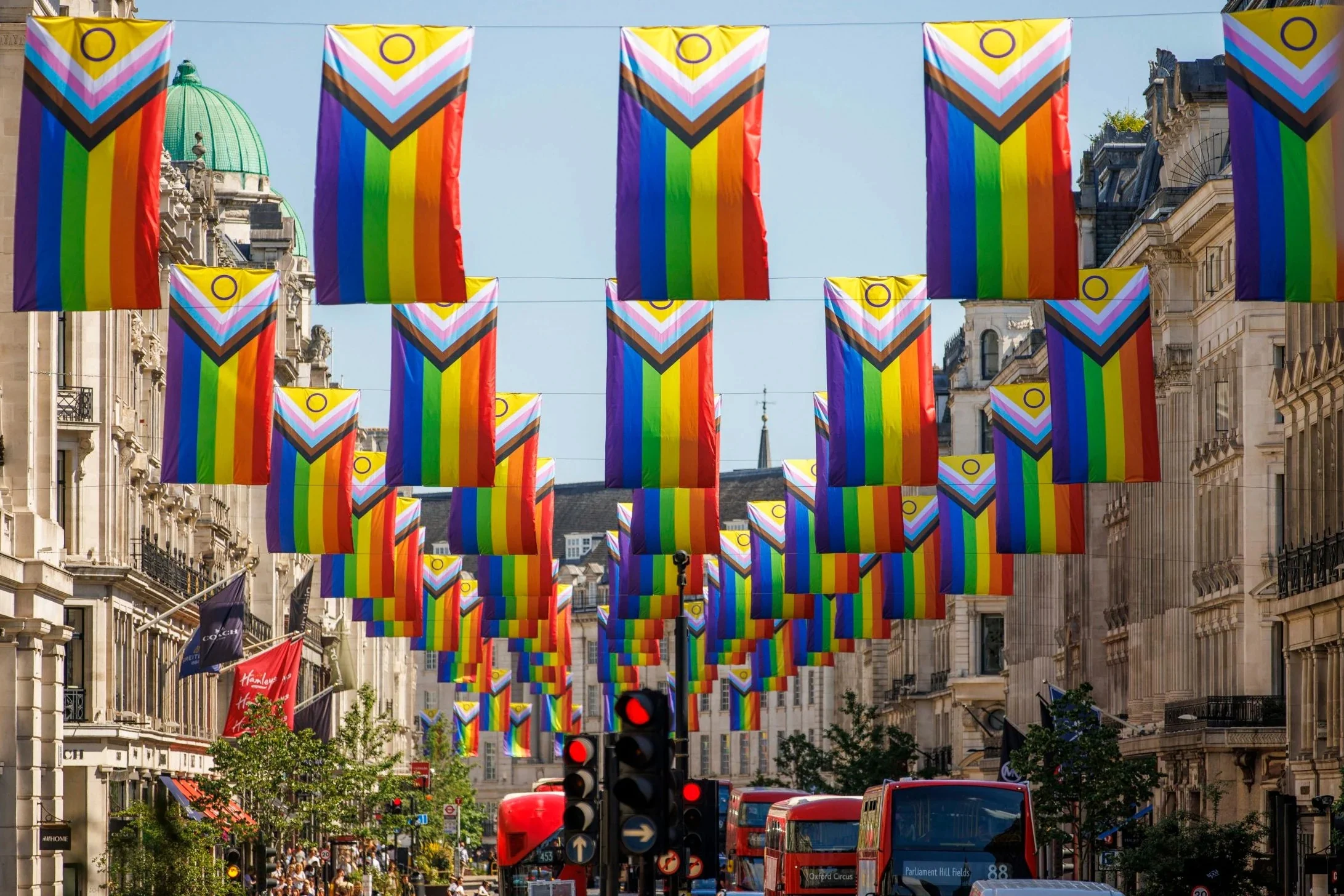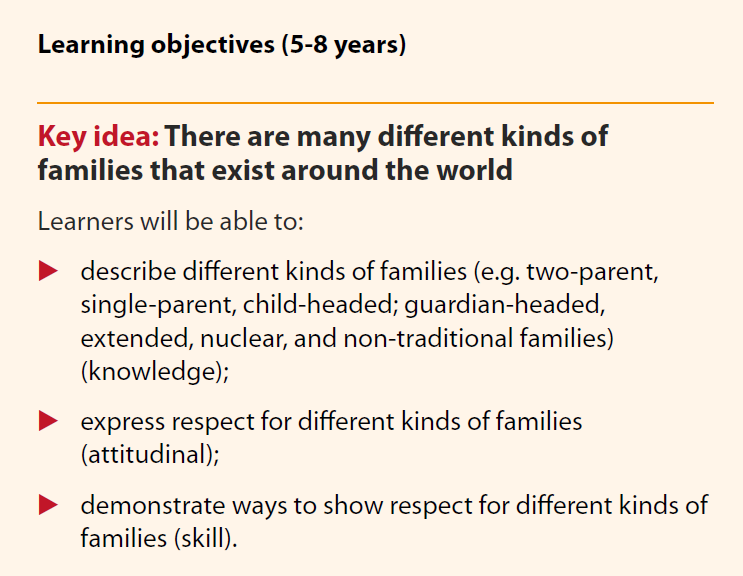
CSE Harms by Age
AWARE wrote “MOE should revise the sexuality education curriculum to bring it in line with the UNESCO International Technical Guidance on Sexuality Education (“UNESCO Guidance”).” [1]
The UN ITGSE is a report that instructs governments about how to implement CSE within their countries.
5-8 years old
Redefine “Family” to include “Non-Traditional Families” (Pg 38)
Children from 5 to 8 years old are taught that “family” includes “non-traditional families”. This includes same-sex unions and possibly polygamous unions.
This lesson normalises non-traditional structures such as same-sex unions and polygamous unions.
They must also have an attitude that respects these different kinds of “families”.
The missing nuance is that while individuals should be respected, not every union is made equal. A 2-father household does not provide a child with maternal care. If “respect” implies equal value, children will not realise the benefits of complementary care from a father and a mother. At 5-8 years old, children are too young to grasp this nuance anyway.
This redefinition of “family” sets a foundation for other ideologies affirming same-sex marriage and LGBTQ lifestyles.

Awareness About Sexual Behaviours (Pg 71)
Is it appropriate for 5-8-year-old children to be taught that sexual behaviour is a form of “love and care”?
Children are not mature enough to understand the right context for sexual behaviours or disciplined enough to control their curious impulses to explore these sexual behaviours.
Given that “family” is redefined to include non-traditional unions, the types of sexual behaviours taught may give young children the wrong idea that sex can be between 2 men or 2 women or a group of people.

9-12 years old
“Right” to Marry Anyone (Pg 43)
9-12-year-olds must have an attitude that all people should be allowed to marry whom they want to.
Given the redefinition of family above and the pro-LGBTQ beliefs of CSE, this includes having an attitude that supports non-traditional structures, including “gay marriage”.
Having this attitude goes beyond mere knowledge. Children must uncritically accept that non-traditional structures are good, even if it means running against the child’s family values and can have negative consequences on individuals and society.

Affirm Transgender Ideology (Pg 50)
Children must learn about gender identity, and some people might feel that their gender identity is different from their biological sex.
Gender identities include the following “male, female, transgender, gender neutral, non-binary, agender, pangender, genderqueer, two-spirit, third gender, none or a combination of these.” Just to name a few.
Children are too young to distinguish ideological concepts from truth. By internalising these gender identities as legitimate, they grow up confused about gender and biological sex. Or worse, about themselves.”
Beyond knowledge, children must have an attitude that “acknowledges” everyone’s gender identity. “Acknowledging” is shown through appreciating and respecting gender identity. This means that the ideological concept of gender identity cannot be challenged, but must be affirmed as truth.

Describe Ways to Feel Pleasure (Pg 70)
Children must know how people feel pleasure from sexual pleasure through kissing, touching, caressing and sexual contact.
While sexual pleasure could enhance a marital relationship, 9-12-year-old children are too young to be married to experience these benefits. By teaching sexual pleasure at a young age, children are prematurely sexually awakened.
They are also not disciplined enough to control their urges to explore sexual pleasure. This creates an opportunity for sexual predators to misguide, sexually groom and exploit children.

Sexual Stimulation gets a Physical Response (Pg 71)
This topic wants children to understand their physical reactions to sexual arousal, especially at the start of puberty. However, it does not teach children how to cool off from arousal. Instead, it teaches children that they can masturbate in private.
Mere awareness about arousal without the skill of self-restraint and calming down leads to heightened sexual curiosity.
There should also be limits to this lesson including not teaching children the means of sexual stimulation, otherwise children may seek arousal through touching themselves or asking/letting others stimulate them.
Certain harms of masturbation are also completely ignored (e.g. desensitisation and sexual fantasy destroy sexual satisfaction in marriages).

How to Wear a Condom
It is very inappropriate to teach young children how to wear a condom. They should be taught to always say no to sexual advances and report advances to a trusted adult rather than learn how to have “safer” sex.
Sexual activities should be completely avoided for minors, not left to them to decide what is “wanted” or “unwanted” at that age. This creates an opportunity for sexual predators to misguide, sexually groom and exploit children.

12-15 years old
Some Relationships can be Sexual
(Pg 41)
Teenagers will be taught that some relationships can become sexual. This not taught as negative but neutral. Teaching teenagers to manage their emotions is also not discouraging them from sexualising close relationships.
The consequence of this lesson is that teenagers are left to decide for themselves which relationships should be sexual.

Pleasurable Sexual Behaviours without Penetration (Pg 72)
Teenagers must recall forms of non-penetrative sexual behaviours that reduce the risk of unwanted pregnancy and STIs that are still pleasurable.
This is inappropriate for teenagers who are protected by law from “giving consent” to any form of sexual activity. They should be taught to always say no to sexual advances rather than to only mitigate risks that come from having sex. Given that teenagers struggle with their hormonal impulses, the opportunity for sexual arousal should be minimised.

Prostitution is Bad but not Prohibited (Pg 72)
Teenagers must be taught what is “transactional sexual activity” and its risks, but are not taught any prohibitions against it.
The main consideration taught about declining transactional sexual activity is unequal power relations. This argument is utilitarian. Teenagers are not taught that sex has significant consequences on relationships and identity, and it should be enjoyed only within a marriage.

Demonstrate How to Buy Condoms
Teenagers must know where to access contraceptives and be able to demonstrate how to get them.
Teenagers are underage, so it is irrelevant for them to demonstrate how to get contraceptives.

15-18 years old
Becoming LGBTQ and Abortion Activists (Pg 47)
Teenagers are taught to become activists supporting laws that affirm and celebrates “sexual orientation and gender identity”. This is presented as both knowledge and skill.
Teenagers should be encouraged to think critically and understand reasons for laws before pushing them to contend for radical political, legal changes.

Combat “homophobia” and “transphobia” (Pg 50)
Teenagers must have the attitude that all people should be able to love who they want to and support people experiencing homophobia or transphobia.
“From this topic, teenagers are taught that the only appropriate way to overcome prejudice is to affirm the LGBTQ lifestyle. They are not taught the nuance that individuals should be cared for, not all beliefs and behaviour are good. They are also misled to think that critical thinking about sexual behaviour and gender are “homophobia” and “transphobia”.

Previous Topic

Next Topic


So, what is so harmful about CSE?
- CSE grooms children from 5 years old to become LGBTQ activists
- CSE exposes children to age-inappropriate sexual behaviours
- CSE promotes a lax attitude toward sexual relationships
This article only highlights the most blatant harms of CSE by age group. To have a deeper understanding of how CSE builds incremental steps across age groups to completely reshape children’s values and social mores, click the button below.
All Topics
1.1 Families
1.2 Friendship, Love and Romantic Relationships
1.3 Tolerance, Inclusion and Respect
1.4 Long-term Commitments and Parenting
2.1 Values and Sexuality
2.2 Human Rights and Sexuality
2.3 Culture, Society and Sexuality
3.1 The Social Construction of Gender and Gender Norms
3.2 Gender Equality, Stereotypes and Bias
3.3 Gender-based Violence
4.1 Violence
4.2 Consent, Privacy and Bodily Integrity
4.3 Safe Use of Information and Communication Technologies (ICTs)
5.1 Norms and Peer Influence on Sexual Behaviour
5.2 Decision-making
5.3 Communication, Refusal and Negotiation Skills
5.4 Media Literacy and Sexuality
5.5 Finding Help and Support
6.1 Sexual and Reproductive Anatomy and Physiology
6.2 Reproduction
6.3 Puberty
6.4 Body Image
7.1 Sex, Sexuality and the Sexual Life Cycle
7.2 Sexual Behaviour and Sexual Response
8.1 Pregnancy and Pregnancy Prevention
8.2 HIV and AIDS Stigma, Treatment, Care and Support
8.3 Understanding, Recognizing and Reducing the Risk of STIs, including HIV

Stay Updated about CSE Harms
To be forewarned is to be forearmed.
No spam. No sales. Only Resources.

